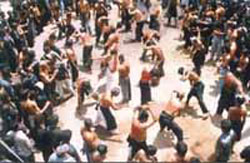|
Muharram is observed by the Shia community of Muslims in
commemoration of the martyrdom of Prophet Mohammed's
grandson, Imam Hussain, who was killed in the Battle of
Karbala in AD 680. The prophet's son-in-law Ali, and
Ali's elder son Hassan, are also remembered during this
period as having suffered and died for righteous causes.
Muharram, or the sacred month, marks the beginning of
the Muslim year.

The word muharram also means respect. The first ten days
of the month are observed as a period of mourning. After
the death of the Prophet Mohammed, the Quran was
considered the final word. The Prophet had named no
successor. One faction of his followers believed that
succession should remain within Mohammed's family, while
another disagreed. After a long dispute, Abu Bakar, a
loyal follower of Mohammed, was elected his successor.
His reign was peaceful, as was that of his successors.
However, during the reign of Ali, the Prophet's
son-in-law, there was opposition from the masses. Ali
was assassinated and his elder son Hassan was poisoned.
His younger son Hussain, his family and his troops, were
tortured and killed, and Hussain's head was severed and
presented to the king.
The killing of Hussain happened on the tenth day of
month of Muharram, and the event was called Ashura. It
is now observed as a day for public expression of grief.
These circumstances divided the Muslim community into
the Shias and the Sunnis. The Shias consider Ali, Hassan
and Hussain the rightful successors of Prophet Mohammed
and mourn their death during Muharram.
Rituals
The Shias observe the entire month as a period of mass
mourning. There is no celebration or expression of joy
of any kind. Women are expected to forsake all
adornments. Public enactments of grief, depicting scenes
from the Battle of Karbala, are carried out in Shia
mosques on the first ten days.

The Shias in India observe certain ceremonies in common,
though the details differ considerably. As soon as the
new moon appears, people clad in black assemble and
recite plaintive verses over sweetened cold drink, in
memory of Imam Hussain.
The cool drink is meant to remind people of the terrible
thirst Hussain and his family had to suffer. Food and
drink are later distributed to the public, especially to
the poor. The first nine days are also spent in making
bamboo and paper replicas of the martyr's tomb. On
Ashura, the tenth day, decorated taziyas, or tombs
embellished with precious metals, are carried through
the city streets. A horse is led in procession in memory
of Hussain's horse, Dul Dul.Wrestlers and dancers enact
scenes depicting the Battle of Karbala. Bare-chested
Shia men strike their body with chains or walk barefoot
over burning coal while uttering cries of anguish for
the torture that Hussain suffered. Apart from reliving
his suffering, it is also an expression of the people's
inability to save Hussain from the brutalities.
Observed In
Muharram is observed in all the Shia communities in
India. Lucknow sees great fervour, as it is the centre
of Shia culture and religious activities in India
|